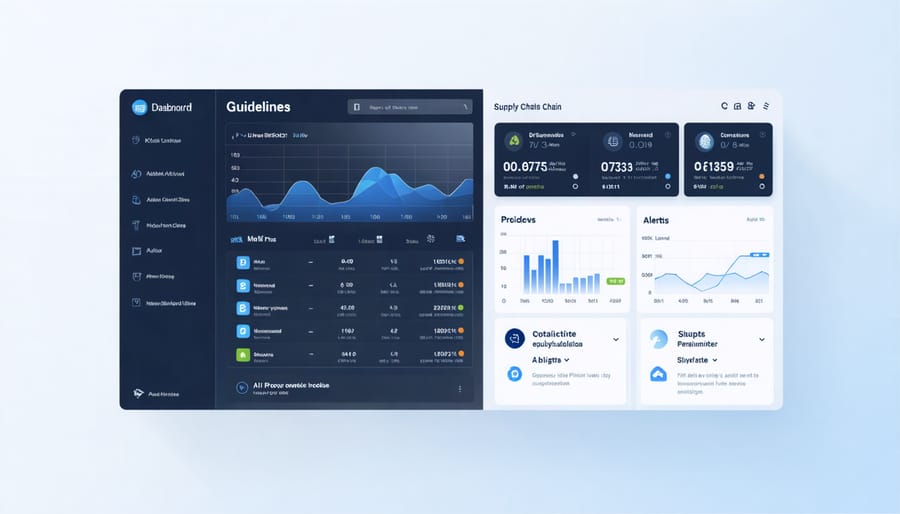Transform supply chain data into actionable intelligence by leveraging AI algorithms that detect patterns, predict disruptions, and automate decision-making in real-time. Machine learning models now parse through millions of data points across global supply networks, extracting meaningful insights that were previously impossible to identify through human analysis alone.
The convergence of artificial intelligence and supply chain management marks a fundamental shift in how businesses derive meaning from their operations. Modern AI systems don’t just process data – they understand context, learn from historical patterns, and generate predictive insights that drive tangible business outcomes. From demand forecasting to inventory optimization, AI transforms raw data streams into clear, actionable recommendations that supply chain managers can trust and implement.
This evolution in data interpretation represents more than just technological advancement; it’s a new paradigm in business intelligence where meaning emerges automatically from the complex interplay of suppliers, logistics, inventory, and customer demand. Organizations that harness AI-enabled meaning gain not just operational efficiency, but a competitive advantage through deeper understanding of their entire value chain.
How AI Transforms Raw Data into Actionable Intelligence
Pattern Recognition and Prediction
In modern supply chains, AI-powered analytics excel at identifying meaningful patterns that might escape human observation. These systems analyze vast amounts of historical and real-time data to detect recurring trends, seasonal fluctuations, and subtle correlations between different supply chain variables.
For example, AI algorithms can recognize patterns in shipping delays by examining weather data, traffic patterns, and historical delivery times. They might discover that specific routes experience consistent delays during certain times of the year, or that particular suppliers tend to face challenges during specific periods. These insights enable businesses to anticipate potential disruptions and take preventive action.
The pattern recognition capabilities extend beyond simple trend analysis. AI systems can identify complex relationships between seemingly unrelated factors, such as how social media sentiment might impact demand for certain products, or how global events could affect supply chain performance. This predictive power helps organizations move from reactive to proactive supply chain management, reducing risks and optimizing operations before problems arise.

Contextual Understanding
In the business world, AI’s ability to understand context goes far beyond simple data processing. It’s like having a highly skilled analyst who not only reads numbers but also understands the story behind them. For example, when analyzing supply chain data, AI systems can distinguish between a temporary spike in demand due to a seasonal event versus an emerging long-term trend.
This contextual intelligence allows AI to make more nuanced decisions. When examining inventory levels, the system considers multiple factors simultaneously – from weather patterns and local events to historical sales data and current market conditions. A retail AI might interpret a sudden increase in umbrella sales differently during a rainy season compared to a sunny day, adjusting its recommendations accordingly.
Modern AI systems also adapt their understanding based on industry-specific contexts. In healthcare supply chains, the AI prioritizes factors like product expiration dates and emergency stockpiling, while in fashion retail, it might focus more on trend cycles and seasonal transitions. This adaptive understanding ensures that AI-generated insights are not just accurate but also practically relevant to specific business environments.
Real-Time Decision Support Systems

Automated Alert Systems
In modern supply chains, AI-powered alert systems act as vigilant digital sentinels, continuously monitoring vast streams of data to identify meaningful events and potential disruptions. These systems leverage machine learning algorithms to establish baseline patterns and detect anomalies that might impact supply chain operations.
For example, when an AI system notices unusual weather patterns in a key shipping route, it can automatically assess the potential impact on delivery times and trigger notifications to relevant stakeholders. The system doesn’t just flag the issue; it provides context-rich alerts with recommended actions based on historical data and predicted outcomes.
These automated systems excel at pattern recognition across multiple data sources. They can simultaneously monitor supplier performance metrics, inventory levels, transportation delays, and market demand fluctuations. When the AI detects meaningful correlations or concerning trends, it prioritizes alerts based on their potential business impact and urgency.
Modern alert systems also feature adaptive learning capabilities. As supply chain managers interact with alerts and take actions, the system learns which events are truly significant and adjusts its notification thresholds accordingly. This reduces alert fatigue and ensures that teams focus on the most critical issues.
The real power of these systems lies in their proactive nature. Instead of waiting for problems to occur, they can predict potential issues days or weeks in advance, giving organizations valuable time to implement mitigation strategies and maintain smooth operations.
Predictive Analytics
Predictive analytics represents one of AI’s most powerful capabilities in extracting meaningful insights from data. By analyzing historical patterns and current trends, AI systems can generate accurate forecasts and actionable recommendations that help businesses make better decisions.
For example, in retail, AI algorithms can predict future sales patterns by examining past transaction data, seasonal trends, and external factors like weather or local events. These predictions help retailers optimize their inventory levels and reduce waste while ensuring products are available when customers need them.
AI achieves this by using sophisticated machine learning models that identify complex relationships in data that humans might miss. These models continuously learn and adapt, improving their accuracy over time. When an AI system notices that ice cream sales spike not just during summer months but also during specific sporting events, it can recommend adjusting inventory accordingly.
The technology goes beyond simple trend analysis. Modern AI systems can generate context-aware recommendations by considering multiple variables simultaneously. In healthcare, predictive analytics can forecast patient readmission risks by analyzing medical histories, demographic data, and treatment outcomes. This enables healthcare providers to implement preventive measures before problems arise.
What makes AI-enabled predictions particularly valuable is their ability to process massive amounts of data in real-time, providing dynamic recommendations that evolve as circumstances change. This adaptability ensures businesses can respond quickly to emerging opportunities or potential challenges.
Creating Value Through AI Integration
Inventory Optimization
AI transforms inventory management by creating meaningful, data-driven strategies that optimize stock levels and reduce costs. Through advanced algorithms and machine learning, AI systems analyze historical sales data, seasonal trends, and market conditions to predict demand with remarkable accuracy.
These intelligent systems continuously monitor inventory levels across warehouses and retail locations, automatically identifying potential stockouts or overstock situations before they occur. For example, a retail chain might use AI to analyze weather patterns, local events, and social media sentiment to adjust inventory levels for specific products in different locations.
The real power of AI in inventory optimization lies in its ability to process multiple variables simultaneously. It can consider factors like lead times, storage costs, transportation expenses, and product shelf life to determine the optimal ordering quantities and timing. This dynamic approach ensures businesses maintain just the right amount of inventory to meet customer demand while minimizing carrying costs.
AI also enables predictive maintenance for inventory management systems, identifying potential supply chain disruptions and suggesting alternative sourcing strategies. For instance, if an AI system detects a potential shortage from a primary supplier, it can automatically recommend backup suppliers or alternative products to maintain business continuity.
By creating meaningful connections between different data points, AI helps businesses move from reactive to proactive inventory management, resulting in improved cash flow, reduced waste, and enhanced customer satisfaction.

Demand Forecasting
AI-driven demand forecasting revolutionizes how businesses predict future needs by analyzing vast amounts of historical data, market trends, and customer experience insights to generate accurate predictions. Unlike traditional forecasting methods, AI systems can process multiple variables simultaneously, including seasonal fluctuations, economic indicators, weather patterns, and social media sentiment.
These intelligent systems learn from past patterns and adapt their predictions in real-time as new data becomes available. For example, a retail chain using AI-enabled demand forecasting might automatically adjust inventory predictions based on upcoming local events, weather forecasts, and recent shopping trends, ensuring optimal stock levels across all locations.
The magic happens through machine learning algorithms that identify complex relationships in data that humans might miss. These algorithms can spot subtle correlations, such as how specific social media discussions might indicate upcoming demand spikes, or how seemingly unrelated events could impact product popularity.
What makes AI-enabled demand forecasting particularly powerful is its ability to provide granular predictions at different levels – from individual SKUs to entire product categories – while considering multiple time horizons. This helps businesses make more informed decisions about inventory management, resource allocation, and supply chain optimization, ultimately reducing costs and improving customer satisfaction.
Overcoming Implementation Challenges
Data Quality Management
Data quality management is fundamental to extracting meaningful insights through AI-enabled systems. Just as a recipe requires fresh ingredients for the best results, AI algorithms need clean, accurate, and reliable data to generate valuable insights. Poor quality data can lead to misleading conclusions and ineffective decision-making, making data quality management a critical priority.
To ensure data quality, organizations should implement a comprehensive framework that includes regular data validation, cleansing, and standardization processes. This involves checking for completeness, accuracy, consistency, and timeliness of data across all sources. For example, in supply chain operations, ensuring that inventory counts, shipping times, and demand forecasts are accurately recorded and updated in real-time is essential for meaningful AI analysis.
Key practices include establishing data governance policies, implementing automated data validation tools, and maintaining clear data documentation. Regular audits help identify and correct data quality issues before they impact AI outcomes. Organizations should also invest in training staff about proper data entry procedures and the importance of maintaining high data quality standards.
Remember that AI systems are only as good as the data they process. By prioritizing data quality management, organizations can ensure their AI-enabled meaning extraction delivers reliable, actionable insights that drive real business value.
Change Management
Integrating AI-enabled meaning into existing operations requires a strategic and methodical approach to change management. Organizations must first assess their current processes and identify areas where AI can add the most value. This evaluation should involve key stakeholders from different departments to ensure comprehensive input and buy-in.
Start with small, pilot projects that demonstrate quick wins and build confidence in the technology. For example, implementing AI-powered demand forecasting in a single product category before rolling it out across the entire inventory. Training programs should be developed to help employees understand how AI tools work and their role in the new workflow.
Clear communication is essential throughout the transition. Leadership should articulate the benefits of AI implementation while addressing concerns about job security and process changes. Regular feedback sessions can help identify challenges early and allow for timely adjustments to the implementation strategy.
Establish metrics to measure success, such as improved accuracy in demand prediction or reduced processing time. These metrics help justify the investment and maintain momentum for broader AI adoption across the organization. Remember that successful change management is an ongoing process that requires continuous monitoring and adjustment.
In today’s rapidly evolving business landscape, AI-enabled meaning has emerged as a cornerstone of modern supply chain optimization. By transforming raw data into actionable insights, AI technologies are helping organizations make smarter decisions, reduce costs, and improve operational efficiency across their supply chain networks.
The impact of AI-enabled meaning extends beyond simple automation. It creates a self-learning ecosystem where supply chains become more intelligent and adaptive over time. Organizations that have embraced this technology have reported significant improvements in demand forecasting accuracy, inventory management, and route optimization, leading to cost savings of up to 15-20% in their operations.
Looking ahead, the role of AI-enabled meaning in supply chain optimization will only grow stronger. As machine learning algorithms become more sophisticated and data collection methods improve, we can expect to see even more innovative applications. From predictive maintenance to real-time risk assessment, the possibilities are virtually limitless.
However, success in implementing AI-enabled meaning requires a strategic approach. Organizations must focus on data quality, invest in the right technology infrastructure, and ensure their teams are properly trained to leverage these tools effectively. Those who master this balance will be well-positioned to thrive in an increasingly competitive global marketplace.
The future of supply chain optimization lies in the intelligent application of AI-enabled meaning, making it an essential consideration for any organization looking to maintain a competitive edge in the digital age.

